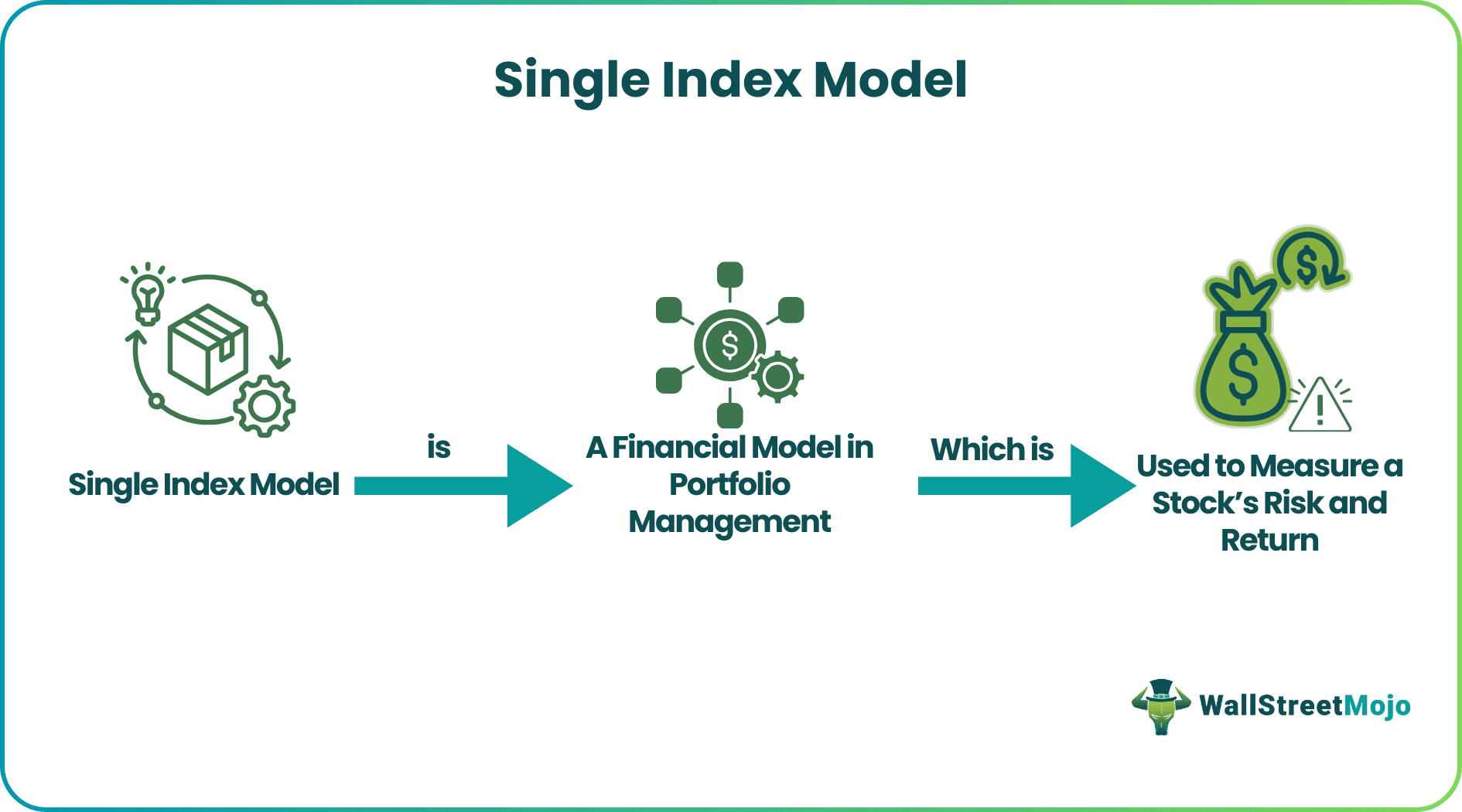Table Of Contents
What Is A Single Index Model?
The Single Index Model (SIM) is a financial model that investors use to analyze the risk and return characteristics of individual securities in a portfolio. It aims to measure a stock's risk and return. With this model, investors can assess the risk and return trade-offs of individual securities concerning the overall market.

The SIM is based on the principle that the performance of a broad market index can explain a security's performance. It represents the relationship between a security's return and the return from the market index with a linear equation. The model is beneficial in portfolio management, asset pricing, and risk analysis to make informed investment decisions.
Key Takeaways
- The Single Index Model (SIM) is a financial structure in technical analysis that helps investors determine the risks and returns of a security.
- This model functions on the concept that a security's performance correlates with a market index's performance. It helps to examine the risk and returns of individual securities within a portfolio.
- Investors can use this model to make well-informed trading decisions regarding portfolio diversification and risk management. It is a valuable instrument for asset pricing, portfolio management, and risk analysis.
Single Index Model Explained
The Single Index Model is a model in technical analysis that helps traders estimate a security's risk and return. It aids in assessing the risk and return characteristics of individual securities within a portfolio. It relies on the idea that a security's performance has a correlation with the market index's performance. In short, the SIM considers a security's return based on systematic and unsystematic risks.
In SIM, the relationship between a security's return and the return of the market index is established with a linear equation. The equation records the security's systematic risk by multiplying the market return with a beta coefficient specific to that security. The beta coefficient measures the sensitivity of the security's returns to the overall market returns. A security with a beta greater than one has higher volatility than the market, whereas a beta less than one indicates lower volatility.
This model lets investors make informed trading decisions regarding portfolio allocation and risk management. Therefore, it is commonly applicable in asset pricing, portfolio management, and risk analysis. It offers a structure for understanding the relationship between individual securities and the market. Moreover, it enables investors to evaluate their portfolios' risk and return characteristics effectively.
Assumptions
The assumptions of the single index model are:
#1 - Linear Relationship
It assumes a linear relationship between the return from an individual security and the return from a market index. It means that the security's return can be represented as a linear function of the market return.
#2 - Systematic And Unsystematic Risk
It is based on the assumption that the return from security comprises two components: systematic risk and unsystematic risk.
#3 - Homogeneous Expectations
It surmises that all the investors have the same expectations about the securities' future returns and risks. Thus, it considers that investors make investment decisions based only on the risk return trade off of the securities.
#4 - Constant Beta
The SIM assumes that the beta coefficient, which measures the sensitivity of a security's returns to the market returns, remains constant over time. Thus, it implies that the relationship between the security and the market index is stable.
#5 - No Transaction Costs Or Taxes
This model considers that there are no transaction costs, taxes, or other frictions associated with buying or selling securities. It assumes that investors can freely trade securities at no charge.
Formula
The single index model formula is as follows:

Advantages And Disadvantages
The advantages of the single index model are:
- The Single Index Model facilitates the evaluation of the risk-return trade-off from individual securities. Investors can assess whether security offers an adequate return given its level of risk by analyzing the relationship between a security's return and its systematic risk. This information is valuable for making informed investment decisions and constructing well-balanced portfolios.
- This model helps diversify the portfolio by distinguishing between systematic and unsystematic risk. Since the model assumes that unsystematic risk can be diversified away, investors can focus on managing and minimizing the systematic risk in their portfolios. Investors can achieve a diversified portfolio that reduces unsystematic risk by combining securities with low correlations to the market.
- It provides a benchmark for evaluating the performance of individual securities. Investors can assess whether the security is over or underperforming related to its systematic risk exposure by comparing the actual returns from the security with its predicted returns based on the model.
The disadvantages of the single index model are:
- The Single Index Model focuses primarily on the relationship between a security and a single market index. It does not consider other factors impacting a security's performance, like interest rates or macroeconomic conditions. Neglecting these factors can result in an inaccurate or incomplete risk and return analysis.
- The model is designed to analyze securities closely related to a market index. It may not be suitable for evaluating or comparing securities that do not correlate strongly with a specific market index.
- It relies on historical data to estimate betas and make predictions. As a result, it may not accurately capture future market dynamics, especially during market instability or structural changes. The model's effectiveness is limited to the reliability and relevance of historical data.
Single Index Model vs CAPM
The differences are as follows:
- Single Index Model: The Single Index Model is more straightforward than the CAPM (Capital Asset Pricing Model). It assumes a linear relationship between a security's return and the return from a market index, which is easier to understand and implement. It focuses on the specific relationship between security and the market index, allowing investors to evaluate the security's systematic risk and its performance related to the market. The Single Index Model provides a framework for assessing the risk-return trade-off from individual securities within a portfolio, aiding investors in making informed decisions about portfolio construction and diversification. However, the Single Index Model has limitations, including its linear and constant beta assumptions, which may not accurately capture the market relationship complexities and security performance.
- CAPM: The CAPM is a more comprehensive model than the Single Index Model. It considers the relationship between security and the market index, as well as the risk-free rate and the overall market risk. It provides a systematic way to estimate the expected return from an individual security based on its beta, the risk-free rate, and the market risk premium. This model includes systematic and unsystematic risk in its analysis, offering a more integrated assessment of a security's risk and return characteristics. It is commonly applicable in asset pricing and portfolio management. The model provides a benchmark for evaluating the performance of securities and constructing efficient portfolios. However, the CAPM relies on certain assumptions, like efficient markets and linear relationships, which may not always hold in real-life situations.

